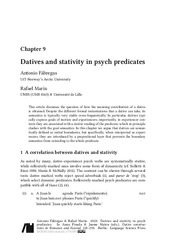| dc.contributor.author | Fábregas, Antonio | |
| dc.contributor.author | Marín, Rafael | |
| dc.date.accessioned | 2023-09-26T12:57:46Z | |
| dc.date.available | 2023-09-26T12:57:46Z | |
| dc.date.issued | 2020 | |
| dc.description | This article discusses the question of how the meaning contribution of a dative
is obtained. Despite the different formal instantiations that a dative can take, its
semantics is typically very stable cross-linguistically. In particular, datives typically express goals of motion and experiencers; importantly, in experiencer contexts they are associated with a stative reading of the predicate, which in principle
clashes with the goal semantics. In this chapter we argue that datives are semantically defined as initial boundaries, but specifically, when interpreted as experiencers, they are introduced by a prepositional layer that prevents the boundary
semantics from extending to the whole predicate. | en_US |
| dc.identifier.citation | Fábregas A, Marín R: Datives and stativity in psych predicates. In: Mateu J, Pineda A. Dative constructions in Romance and beyond, 2020. Language Science Press p. 221-238 | en_US |
| dc.identifier.cristinID | FRIDAID 1847060 | |
| dc.identifier.doi | https://doi.org/10.5281/zenodo.3776549 | |
| dc.identifier.isbn | 978-3-96110-250-1 | |
| dc.identifier.issn | 2699-741X | |
| dc.identifier.issn | 2568-7336 | |
| dc.identifier.uri | https://hdl.handle.net/10037/31216 | |
| dc.language.iso | eng | en_US |
| dc.publisher | Language Science Press | |
| dc.rights.accessRights | openAccess | en_US |
| dc.rights.holder | Copyright 2020 The Author(s) | en_US |
| dc.rights.uri | https://creativecommons.org/licenses/by/4.0 | en_US |
| dc.rights | Attribution 4.0 International (CC BY 4.0) | en_US |
| dc.title | Datives and stativity in psych predicates | en_US |
| dc.type.version | publishedVersion | en_US |
| dc.type | Chapter | en_US |
| dc.type | Bokkapittel | en_US |


 English
English norsk
norsk
